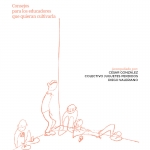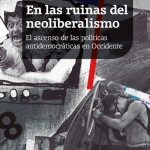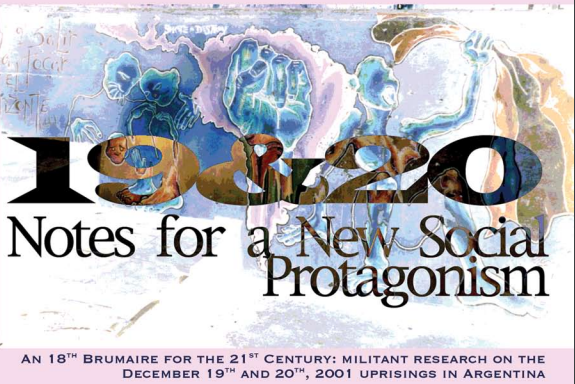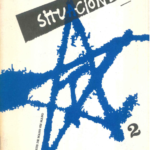Esferas de la insurrección // Suely Rolnik

Un fragmento del flamante libro de la psicóloga, docente y activista brasileña Suely Rolnik, traducido por Damian Kraus y editado por Tinta Limón Ediciones. “Es necesario resistir en el propio campo de la política de producción de la subjetividad y del deseo dominante en el régimen en su versión contemporánea –es decir, resistir al régimen dominante en nosotros mismos–, lo cual no cae del cielo ni se encuentra listo en alguna tierra prometida”, dice la autora.
Una atmósfera siniestra envuelve el planeta. El aire del ambiente, saturado de las partículas tóxicas del régimen colonial-capitalístico, nos sofoca.
Con sucesivas transmutaciones, este régimen viene perdurando y sofisticándose desde finales del siglo XV, la época de su fundación. Su versión contemporánea –financierizada, neoliberal y globalitaria– empieza a formarse en el paso del siglo XIX al siglo XX y se intensifica luego de la primera guerra mundial, cuando se internacionalizan los capitales. Pero a partir de mediados de la década de 1970 llega a su poder pleno, al afirmarse contundentemente –y no por casualidad– luego de los movimientos micropolíticos que sacudieron el planeta durante las décadas de 1960 y 1970. Durante ese período –mediados de la década de 1970– se concretan los primeros pasos de un trabajo de desciframiento del actual rumbo de este régimen en su compleja naturaleza, es decir, de los principios que la rigen y de los factores que engendran las condiciones para su consolidación.
Sin embargo, y tal como suele suceder en los momentos de transición radical, fundamentalmente a partir de mediados de la década de 1990 –cuando se empiezan a hacer sentir con mayor claridad sus efectos nefastos sobre la vida cotidiana– este desciframiento se expande y se densifica, dando lugar a un debate colectivo que viene desplegándose desde entonces. Dicho debate adquiere su impulso en la experiencia de los movimientos sociales que emergen en el transcurso de la década anterior como reacción a la toma del poder mundial por parte del actual régimen. Como rayos, esos movimientos han venido irrumpiendo en los cielos del capitalismo globalitario cada vez que se forman nubes tóxicas debido a la densificación de la atmósfera en alguna de sus regiones, cuando su perversión supera el límite de lo tolerable. La intensidad de irrupción de dichos movimientos –equiparable a la de la violencia del régimen que los había desencadenado– tiende entonces a provocar una desestabilización temporal de su tiránica omnipotencia. Y a la misma velocidad que surgen desaparecen para resurgir enseguida, de otro modo y en otros lugares, movilizados por nuevos acontecimientos que nos instalan en lo intolerable –lo cual evidentemente los lleva a producir otras cartografías, otros sentidos, distintos a los que los preceden. Esta serie de movimientos se extiende hasta comienzos de la década del 2000, cuando se interrumpe, para volver a reaparecer luego de la crisis de 2008. La nueva serie de movimientos, que se encuentra actualmente aún en curso, emerge en diferentes puntos del planeta, fundamentalmente a partir del comienzo de la segunda década de este siglo, y precede a la escritura de este ensayo.
En el contexto de estos movimientos y del debate a ellos asociado se inserta el presente ensayo. Su punto de partida es uno de los temas del orden del día en esta construcción colectiva: el modo de relación entre el capital y la fuerza vital, propio del régimen en su actual versión, y por entero distinto a su modo fordista. En esta nueva versión, el ámbito de la fuerza vital de la cual se alimenta el capitalismo ya no se reduce a su expresión como fuerza de trabajo, lo que implica una metamorfosis radical de la propia noción de trabajo. Eso se acompaña de una paulatina dilución de la forma del Estado democrático de derecho, de la cual dependían las leyes laborales propias del régimen en su versión anterior.
El abuso de la vida
Si bien la base de la economía capitalista es la explotación de la fuerza de trabajo y de la cooperación inherente a la producción para extraer plusvalía de ellas, dicha operación –a la que podemos denominar “proxenetización” o “cafisheo” para asignarle un nombre que diga más precisamente la frecuencia vibratoria de sus efectos en nuestros cuerpos– fue cambiando de figura con las transfiguraciones del régimen en el transcurso de los cinco siglos que nos separan de su origen. En su nueva versión, es de la propia vida que el capital se apropia; más precisamente, de su potencia de creación y transformación en la emergencia misma de su impulso –es decir, en su esencia germinal–, como así también de la cooperación de la cual dicha potencia depende para efectuarse en su singularidad. La fuerza vital de creación y de cooperación es así canalizada por el régimen para construir un mundo acorde con sus designios. En otras palabras, en su nueva versión, es la propia pulsión de creación individual y colectiva de nuevas formas de existencia, y sus funciones, sus códigos y sus representaciones lo que el capital explota, haciendo de ella su motor. Por eso la fuente de la cual el régimen extrae su fuerza deja de ser exclusivamente económica para serlo también intrínseca e indisociablemente cultural y subjetiva –por no decir ontológica–, lo cual la dota de un poder perverso más amplio, más sutil y más difícil de combatir.
Frente a este cuadro, se hace evidente que no basta con actuar en la esfera macropolítica, en donde actúan tradicionalmente las izquierdas, sobre todo las institucionales. Esto explicaría incluso su impotencia ante los rumbos actuales del régimen colonial-capitalístico. De acuerdo con la visión introducida por autores que pensaron la nueva relación entre el capital y el trabajo, con su enfoque en la apropiación por el capital de la potencia de creación –especialmente Toni Negri y Michael Hardt, quienes denominaron al nuevo pliegue del régimen como “capitalismo cognitivo”–, la resistencia actualmente pasaría por un esfuerzo de reapropiación colectiva de esa potencia para construir con ella aquello a lo que estos autores designan como “lo común”. En diálogo con ellos, podemos definir a lo común como el campo inmanente de la pulsión vital de un cuerpo social cuando este la toma en sus manos, de manera tal de direccionarla hacia la creación de modos de existencia para aquello que pide paso. También según Hardt y Negri, de esta construcción de lo común resultan cambios en las formas de la realidad. Su argumento indica que si en el capitalismo industrial las formas de la fuerza de trabajo y su cooperación –en este caso organizadas como producción en cadena– estaban predefinidas por el capital, en el modo de expropiación de esta fuerza propio de la nueva versión del régimen, sus formas no están predeterminadas, pues es de la propia potencia de su construcción que se constituye el capital fijo. Esto abriría una posibilidad de autonomía en la orientación del destino de la fuerza vital. Sin embargo, dicha fuerza es desviada a favor de la producción de escenarios destinados a la acumulación de capital.
También según estos autores, y partiendo del principio de que la potencia vital pertenece a quien trabaja, es precisamente la experiencia de su relativa autonomía la que genera las condiciones favorables para su reapropiación. Retomando el diálogo con ellos, podemos añadir que de la reapropiación deseante, individual y cooperativa, del destino ético de la pulsión vital –en síntesis, de su reapropiación ontológica–, puede resultar un desvío colectivo de su abuso a manos del régimen en dirección hacia una ética de la existencia. Sin embargo, y tal como los autores mencionados lo señalan, su reapropiación por parte de la sociedad es virtual mientras no encuentra formas de actualización, lo cual depende de una voluntad colectiva de actuar con miras a la construcción de lo común, que no está dado a priori.
Es exactamente en esta dirección que vienen actuando algunos de los mencionados movimientos colectivos que irrumpen a mediados de la década de 1990 y vuelven a irrumpir en distintos momentos desde entonces, en el activismo propiamente dicho y, no por casualidad, también en el arte, con sus fronteras cada vez más indiscernibles. En esa transterritorialidad se crean las condiciones más favorables para la movilización de la potencia de creación de las prácticas activistas, como así también de la potencia micropolítica en las prácticas artísticas que, aunque su esencia reside en dicha potencia, se encuentran hoy en día desprovistas de ella en favor de su proxenetización por el capital, que encuentra en ese dominio una fuente privilegiada para su expropiación.
Una inquietud mueve la escritura de este ensayo: si bien ya constituye un paso importante reconocer que no basta con resistir macropolíticamente al actual régimen, y que urge también e igualmente obrar para reapropiarse de la fuerza de creación y cooperación –es decir, actuar micropolíticamente–, reconocer esto racionalmente no asegura acciones eficaces en esta dirección. Sucede que la reapropiación del impulso de creación depende de que esta incida sobre las acciones del deseo, de modo tal de imprimirle su dirección y su modo de relación con el otro. Sin embargo, tales acciones tienden a chocar contra la barrera de la política de producción de la subjetividad y del deseo inherente al régimen vigente. Al igual que en cualquier otro régimen, es el modo de subjetivación que en él se produce lo que le imprime su consistencia existencial, sin la cual no se sostendría; uno no existe sin el otro. En el caso del nuevo pliegue del régimen colonial-capitalístico, el cafisheo de la pulsión vital nos impide reconocerla como nuestra, lo que hace que su reapropiación no sea tan obvia como lo pretendería nuestra vana razón.
Si se tiene esto en cuenta, resulta evidente que no se logra retomar las riendas de esa potencia mediante un sencillo decreto de la voluntad, por más imperiosa que esta sea, ni tampoco a través de la conciencia, por más lúcida y bienintencionada que la misma sea. Ni mucho menos se logra reapropiarse de ella colectivamente como un solo cuerpo supuestamente natural que estaría dado a priori y, por si fuera poco, en sinergia absoluta entre todos los elementos que lo componen, tal como lo pretenden los heraldos mesiánicos de un paraíso terrenal. Es necesario resistir en el propio campo de la política de producción de la subjetividad y del deseo dominante en el régimen en su versión contemporánea –es decir, resistir al régimen dominante en nosotros mismos–, lo cual no cae del cielo ni se encuentra listo en alguna tierra prometida. Al contrario, es un territorio al cual debe conquistárselo y construírselo incansablemente en cada existencia humana que compone una sociedad, y esto incluye intrínsecamente a su universo relacional. De dichas conexiones se originan comunidades temporales que aspiran a actuar en esa dirección en la construcción de lo común. Con todo, tales comunidades jamás ocupan el cuerpo de la sociedad como un todo, pues este se hace y se rehace en el inexorable embate entre distintos tipos de fuerzas.
Pero, ¿cómo liberar la vida de su proxenetización?
Insurgir o sublevarse en este terreno implica diagnosticar el modo de subjetivación vigente y el régimen de inconsciente que le es propio; y que se investigue cómo y por dónde se viabiliza un desplazamiento cualitativo del principio que lo rige. Sin ello, la tan aclamada propuesta de reapropiación colectiva de la fuerza creadora como profilaxis de la patología del presente no saldrá del laboratorio de las ideas, y corre el riesgo de permanecer confinada en el plano imaginario, con sus hermosas ilusiones alentadoras.
Propongo designar como “inconsciente colonial-capitalístico” a la política del inconsciente dominante en este régimen y que atraviesa toda su historia, pues lo único que varían son sus modalidades junto con sus transmutaciones y sus formas de abuso de la fuerza vital de creación y cooperación. En tal sentido, podemos también denominarlo “inconsciente colonial-cafisheístico”, por las razones antes evocadas. Es probablemente a la resistencia contra este régimen del inconsciente que se refieren Deleuze y Guattari cuando claman por una protesta de los inconscientes en el año 1972, cuando apenas si se esbozaba el trabajo de elaboración colectiva de la audaz experiencia de mayo de 1968 y, simultáneamente, la toma del poder por el nuevo régimen manifestaba entonces sus primeras señales, aun nebulosas.
La intención que mueve el presente texto es la de escrutar la modalidad actual del inconsciente colonial-cafisheístico introducida por el capitalismo financierizado y neoliberal, la cual se define, insisto, por el secuestro de esa fuerza en el propio nacimiento de su impulso germinador de mundos. Pero, ¿cómo esquivar ese régimen del inconsciente en nosotros mismos y en nuestro entorno? En otras palabras, ¿en qué consistiría la mentada protesta de los inconscientes?
La respuesta a esta pregunta requiere de un trabajo de investigación que solo puede efectuarse en el terreno de la propia experiencia subjetiva. Habrá que buscar vías de acceso a la potencia de la creación en nosotros mismos: la naciente del movimiento pulsional que mueve las acciones del deseo en sus distintos destinos. Un trabajo de experimentación sobre uno mismo que demanda una atención constante. En su ejercicio, la formulación de ideas es inseparable de un proceso de subjetivación en el cual esa reapropiación se vuelve posible durante breves y fugaces momentos, y cuya consistencia, su frecuencia y su duración se amplían paulatinamente, a medida que ese trabajo avanza.
De este modo, el trabajo necesario para contestar esta pregunta nos exige que, junto con el desplazamiento de la política de producción de la subjetividad y del deseo dominante en la nueva versión de la cultura moderna occidental colonial-capitalística, desplacemos igualmente la política de producción de pensamiento, propia de esa cultura, activando su médula vital y su habilidad para desarmar las configuraciones del poder. Sin ello, nuestra intención se ahoga en la orilla. Desde la perspectiva de esos desplazamientos, pensar y sublevarse se convierten en una sola y la misma práctica: una no avanza sin la otra. Corrobora esta indisociabilidad el hecho de que, si bien tal práctica solo puede plasmarse por principio en el ámbito de cada existencia, la misma no transcurre aisladamente. En primer lugar, porque su propio motor no empieza ni termina en el individuo, ya que su origen reside en los efectos de las fuerzas del mundo que habitan en cada uno de los cuerpos que lo componen, y su producto lo constituyen las formas de expresión de esas fuerzas, procesos de singularización en cada uno de ellos, los cuales se plasman en un terreno común a todos, y lo transfiguran. Nada que ver con la autorreflexividad, la interioridad o los temas privados. La segunda razón, que resulta inseparable de la primera, consiste en que tal práctica se alimenta de resonancias de otros esfuerzos que van en la misma dirección y de la fuerza colectiva que promueven, no solamente a causa de su poder de polinización sino también y fundamentalmente por la sinergia que producen.
Resonancias de este tipo no son únicamente hallables en un campo determinado del saber que tendría el presunto monopolio de la expertise en el tema, tal como el de los estudios culturales, poscoloniales o queer, por ejemplo, que serían los más obvios. Podemos encontrarlas en diversos campos de la práctica teórica y, más aún, pueden surgir a partir de la producción de pensamiento en cualquier esfera de la vida colectiva: desde la así llamada “alta cultura” hasta la canción popular, pasando por las experimentaciones que se llevan a cabo –entre otras esferas– en la sexualidad, en la relación con el otro, en la agricultura o en aquello que los pueblos indígenas han venido insistiendo en decirnos desde que osaron tomar la palabra públicamente en alto y buen tono. Tales resonancias y las sinergias que producen crean las condiciones para la formación de un cuerpo colectivo común cuya potencia de invención, al actuar en direcciones singulares y variables, pueda llegar a tener la fuerza suficiente como para contener el poder de las fuerzas que prevalecen en otras constelaciones, aquellas que se componen de cuerpos que intentan cafishear la pulsión vital ajena o que se entregan a su proxenetización. Con esas sinergias se abren caminos para desviar tal potencia de su destino destructor.
Es esta precisamente la perspectiva que rige el pensamiento en la elaboración de este ensayo; y es, por ende, y por principio, no solo transdisciplinaria sino también indisociable de una pragmática clínicopolítica. Al ser este necesariamente el trabajo de muchos y de cada uno, que nunca se agota, las ideas que aquí se compartirán constituyen tan solo algunas herramientas conceptuales entre las que están hoy en día inventándose en múltiples direcciones para abordar la pregunta anteriormente formulada: “¿Cómo liberar la vida de su proxenetización?”. Este proceso de invención resulta de la inteligencia colectiva que viene activándose a una velocidad exponencial, movilizada por la urgencia de enfrentar el alto grado de perversión del régimen en su nueva versión. Las herramientas aquí sugeridas nos ayudarán a examinar tanto la política de producción de la subjetividad, del deseo, del pensamiento y de la relación con el otro que nos lleva a una entrega ciega a la apropiación de la fuerza de creación como a aquella en la cual se viabiliza su reapropiación. Contaremos así con un criterio para establecer la distinción entre esas micropolíticas y el tipo de formaciones del inconsciente que resulta de cada una de las mismas en el campo social.






